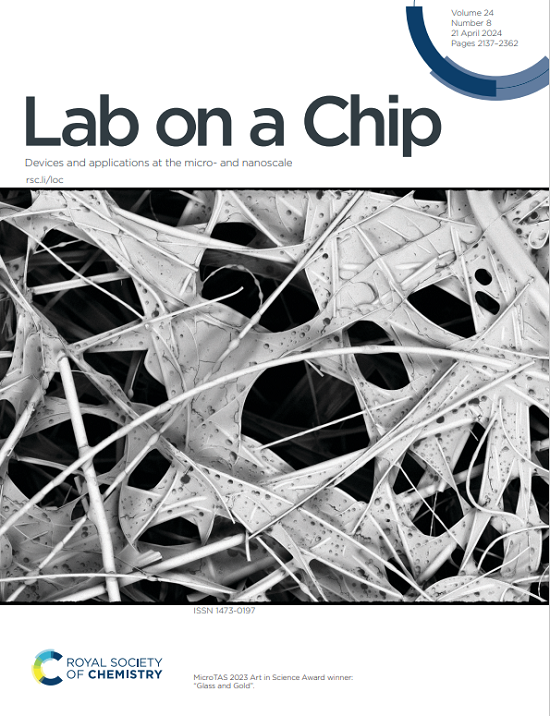Fast capillary flow on µPADs with hollow channels packaged by thermal contraction tube
IF 6.1
2区 工程技术
Q1 BIOCHEMICAL RESEARCH METHODS
引用次数: 0
Abstract
Microfluidic paper-based analytical devices (µPADs), as an excellent platform for point-of-care diagnostics, is becoming more and more popular. Flow rate control of liquid samples on µPADs is highly intriguing for improving the detection performance of these devices. In this work, we develop a novel package method for µPADs using thermal contraction tube, which can be easily used to create hollow channels on µPADs and generate fast capillary flow of liquid samples. Using this package method, we create hollow channels above a single layer of cellulose paper strip and between two layers of cellulose paper strips respectively. We investigate the influence of the height of the hollow channels on the capillary flow rate, and find that the average flow rate increases with the height of hollow channels with height up to 0.8 mm. For the µPADs with hollow channels above a single layer of paper strip, the maximum increase can reach 865% while the maximum increase is 1328% for µPADs with hollow channels between two layers of paper strips when the height of hollow channel is 0.8 mm. As a proof of concept, we use µPADs with hollow channels above a single layer of paper strip for glucose detection in blood plasma, showing much higher efficiency compared to naked paper strip. In addition, we can achieve a fluidic switch function on these µPADs with hollow channels by simply pressing and releasing the thermal contraction tubes, with the possibility to speed up or slow down. Furthermore, we use µPADs with 0.8 mm hollow channels between two layers of paper strips for fast measurement of viscosity of liquid samples. We successfully measure viscosity of liquid samples including water, mixture of glycerol and water, mixture of poly(ethylene glycol) (PEG) and water, mixture of sodium carboxymethylcellulose (SCMC) and water, as well as blood plasma and whole blood, with viscosity having a range of three orders. With advantages including easy handling and low cost, we believe µPADs packaged by this method can find more applications in point-of-care diagnostics.热收缩管封装的空心通道µpad上的快速毛细管流动
微流控纸基分析设备(µPADs)作为一种出色的即时诊断平台,正变得越来越受欢迎。µpad上液体样品的流速控制对于提高这些设备的检测性能非常有趣。在这项工作中,我们开发了一种使用热收缩管的新型封装方法,该方法可以很容易地在µpad上创建空心通道,并产生液体样品的快速毛细管流动。使用这种包装方法,我们分别在单层纤维素纸条上方和两层纤维素纸条之间创建空心通道。研究了空心孔道高度对毛细管流速的影响,发现平均流速随空心孔道高度的增加而增加,孔道高度可达0.8 mm。单层纸条上方有中空通道的µpad,当中空通道高度为0.8 mm时,最大增幅可达865%,两层纸条之间有中空通道的µpad,最大增幅为1328%。作为概念验证,我们在单层纸条上方使用带有空心通道的µpad进行血浆中的葡萄糖检测,与裸纸条相比,效率更高。此外,我们可以通过简单地按压和释放热收缩管,在这些带有空心通道的µpad上实现流体开关功能,并可以加速或减速。此外,我们在两层纸条之间使用带有0.8 mm空心通道的µpad,用于快速测量液体样品的粘度。我们成功地测量了液体样品的粘度,包括水,甘油和水的混合物,聚乙二醇(PEG)和水的混合物,羧甲基纤维素钠(SCMC)和水的混合物,以及血浆和全血,粘度范围为三个数量级。凭借易于操作和低成本等优势,我们相信这种方法封装的µpad可以在即时诊断中找到更多应用。
本文章由计算机程序翻译,如有差异,请以英文原文为准。
求助全文
约1分钟内获得全文
求助全文
来源期刊

Lab on a Chip
工程技术-化学综合
CiteScore
11.10
自引率
8.20%
发文量
434
审稿时长
2.6 months
期刊介绍:
Lab on a Chip is the premiere journal that publishes cutting-edge research in the field of miniaturization. By their very nature, microfluidic/nanofluidic/miniaturized systems are at the intersection of disciplines, spanning fundamental research to high-end application, which is reflected by the broad readership of the journal. Lab on a Chip publishes two types of papers on original research: full-length research papers and communications. Papers should demonstrate innovations, which can come from technical advancements or applications addressing pressing needs in globally important areas. The journal also publishes Comments, Reviews, and Perspectives.
 求助内容:
求助内容: 应助结果提醒方式:
应助结果提醒方式:


